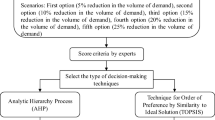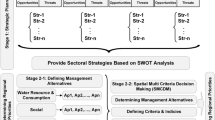Abstract
Confronting climate change is a daunting challenge that requires policies for climate adaptation in the field of water resources management. This paper proposes a method for reservoir operation associated with climate-change projections aimed at ensuring the sustainability of agricultural water supply. The method is applied to the Aidoghmoush reservoir in East Azerbaijan province (Iran) employing climate-change projections for 2040–2069, and compares the future-period results with those calculated for the baseline period (1971–2000). The water-supply system depending on the Aidoghmoush reservoir is simulated using the climate-change projections. The water-supply system simulations are ranked with two multi-criteria decision-making (MCDM) methods according to their suitability for satisfying agricultural water demands and sustain cropping patterns. These are the multi-criteria optimization and compromise resolution (VIKOR) and the Fuzzy Order Weighted Average (FOWA) MCDM methods. The MCDM methods identify the best water-supply management alternatives for climate-change adaptation.









Similar content being viewed by others
References
Abrishamchi A, Ebrahimian A, Tajrishi M, Mariño MA (2005) Case study: application of multicriteria decision making to urban water supply. J Water Resour Plan Manag 131(4):326–335. https://doi.org/10.1061/(ASCE)0733-9496(2005)131:4(326)
American Society of Civil Engineers (ASCE) (1998) Sustainability criteria for water resources systems. (task committee on sustainability criteria, water resources planning and management division, ASCE and working group, UNESCO/IHP IV project M-4.3). ASCE, Reston
Ansarifar E, Shahidi F, Mohebbi M, Ramezanian N, Koocheki A, Mohamadian A (2019) Optimization of limonene microencapsulation based on native and fibril soy protein isolate by VIKOR method. LWT. https://doi.org/10.1016/j.lwt.2019.02.071
Ashofteh P-S (2015) Developing flexible strategies in water resources and consumption management for adaptation with climate change. Ph.D. dissertation, Dept. of Irrigation and Reclamation Engineering, University of Tehran, Karaj, Iran
Ashofteh P-S, Bozorg-Haddad O, Mariño MA (2015) Risk analysis of water demand for agricultural crops under climate change. J Hydrol Eng 20(4). https://doi.org/10.1061/(ASCE)HE.1943-5584.0001053
Ashofteh P-S, Bozorg-Haddad O, Loáiciga HA (2017) Development of adaptive strategies for irrigation water demand management under climate change. J Irrig Drain Eng 143(2):04016077. https://doi.org/10.1061/(ASCE)IR.1943-4774.0001123
Chang C-L, Hsu C-H (2009) Multi-criteria analysis via the VIKOR method for prioritizing land-use restraint strategies in the Tseng-Wen reservoir watershed. J Environ Manag 90(11):3226–3230. https://doi.org/10.1016/j.jenvman.2009.04.020
Cristóbal JRS (2011) Multi-criteria decision-making in the selection of a renewable energy project in Spain: the VIKOR method. Renew Energy 36(2):498–502. https://doi.org/10.1016/j.renene.2010.07.031
Denpontin M, Mascarola H, Spronk J (1983) A user oriented listing of MCDM. Revue Beige de Research Operationelle 23:3–11
Farajzadeh M, Madani K, Massah A, Davtalab R (2014) Climate change on reliability of water delivery in downstream Karkheh River basin and its adaptation strategies. Journal of Soil and Water Resources Conservation 3(3):49–63 (In Persian)
Hashimoto T, Stedinger JR, Loucks DP (1982) Reliability, resiliency and vulnerability criteria for water resources system performance evaluation. Water Resour Res 18(1):14–20
IPCC (2007) Climate change 2007 : mitigation. In: Davidson O, Swart R (eds) Contribution of working group I to the fourth assessment report of the intergovernmental panel on climate change. Cambridge University Press, Cambridge, p 881
IPCC-TGCIA (1999) Guidelines on the use of scenario data for climate impact and adaptation assessment. Version 1. Prepared by Carter, T. R., Hulme, M. and Lal, M. intergovernmental panel on climate change. Task Group on Scenarios for Climate Impact Assessment, 69 p
Jaber JO, Mohsen MS (2001) Evaluation of non-conventional water resources supply in Jordan. Desalination 136(1-3):83–92
Jahan A, Mustapha F, Yusof Ismail M, Sapuan SM, Bahraminasab M (2011) A comprehensive VIKOR method for material selection. Mater Des 32(3):1215–1221. https://doi.org/10.1016/j.matdes.2010.10.015
Jiménez-Cisneros B (1996) Water availability index based on quality and quantity: its application in Mexico. Water Sci Technol 34(12):165–172
Kiani B, Liang RY, Gross J (2018) Material selection for repair of structural concrete using VIKOR method. Case Studies in Construction Materials 8:489–497. https://doi.org/10.1016/j.cscm.2018.03.008
Kim Y, Chung E-S (2014) An index-based robust decision making framework for watershed management in a changing climate. Sci Total Environ 473-474:88–102
Kim Y, Park D, Um M-J, Lee H (2015) Prioritizing alternatives in strategic environmental assessment (SEA) using VIKOR method with random sampling for data gaps. Expert Syst Appl 42(22):8550–8556. https://doi.org/10.1016/j.eswa.2015.07.010
Krol MS, de Vries MJ, van Oel PR, de Araújo JC (2011) Sustainability of small reservoirs and large scale water availability under current conditions and climate change. Water Resour Manag 25(12):3017–3026
Kundzewicz ZW, Radziejewski M, Pinskwar I (2006) Precipitation extremes in the changing climate of Europe. Clim Res 31(1):51–58
Liou JJH, Tsai C-Y, Lin R-H, Tzeng G-H (2011) A modified VIKOR multiple-criteria decision method for improving domestic airlines service quality. J Air Transp Manag 17(2):57–61. https://doi.org/10.1016/j.jairtraman.2010.03.004
Loucks DP (1997) Quantifying trends in system sustainability. Hydrol Sci J 42(4):513–530
McMahon TA, Adeloye AJ, Zhou S-L (2006) Understanding performance measures of reservoirs. J Hydrol 324(1-4):359–382
Opricovic S (1998) Multi criteria optimization of civil engineering systems. Faculty of Civil Engineering, Belgrad, 2(1), 5-21
Raskin P, Hansen E, Zhu Z, Stavisky D (1992) Simulation of water supply and demand in the Aral Sea Region. Water Int 17(2):55–67
Sieber J, Swartz C, Huber-Lee A (2005) User guide for WEAP21. Stockholm Environment Institute Tellus Institute, Stockholm
Tecle A (1988) Choice of multi criterion decision making techniques for watershed management. Ph.D. Dissertation, University of Arizona
Varanou E, Gkouvatson E, Baltas E, Mimikou M (2002) Quantity and quality integrated catchment modeling under climate change with use of soil and water assessment tool model. J Hydrol Eng 7(3):228–244
Wilby RL, Harris I (2006) A framework for assessing uncertainties in climate change impacts: low flow scenarios for the riverThomes, U.K. Water Resour Res 42(2):W02419
Yager RR (1993) Families of OWA operators. Fuzzy Sets Syst 59(2):125–148. https://doi.org/10.1016/0165-0114(93)90194M
Author information
Authors and Affiliations
Corresponding author
Ethics declarations
Conflict of Interest
None.
Additional information
Publisher’s Note
Springer Nature remains neutral with regard to jurisdictional claims in published maps and institutional affiliations.
Appendix
Appendix
Seven indexes, each corresponding to a decision criterion, are employed in this study. Their equations and intervening variables are presented in this section.
1.1 Time Reliability Criteria
This index measures the capacity of a reservoir system to satisfy downstream water demands (Hashimoto et al. 1982):
where: α = time reliability index; N = the number of periods (months) in which the reservoir release is equal or greater than the downstream water demand (the number of satisfactory states); count = a counting function (it counts periods when releases are equal to or larger than water demand during the operational period); Dt = the volume of downstream water demand in period t; Rt = the reservoir release in period t; T = the number of operational periods (number of months).
1.2 Vulnerability Index
This index measures the average volumetric severity of failure to meet downstream water demands by reservoir system releases (Hashimoto et al. 1982):
in which ν = vulnerability index; Dmax = the maximum water demand among all the monthly water demands in the operational period; ND = the number of months in which the reservoir release is less than the downstream water demand, i.e., the summation on the right-hand side of Eq. (15) applies to reservoir releases and water demands in months such that Rt < Dt.
1.3 Resiliency Index
Measures how quickly a reservoir system recovers from a water-supply deficit (water-supply deficit is an unsatisfactory state whereby the monthly reservoir release is less than the downstream monthly water demand) to a situation whereby the monthly water release satisfies the monthly water demand (a satisfactory state) (this is a modified definition of resiliency of that by Hashimoto et al. 1982):
where β = resiliency index; N′ = the number of months in which a satisfactory state occurs immediately after an unsatisfactory state; ND = the number of months in which the reservoir release is less than the downstream water demand (this is the number of unsatisfactory states).
1.4 Sustainability Index
The sustainability index combines the reliability, vulnerability, and resiliency indexes and is defined by the following equation (Loucks 1997):
in which γ = sustainability index.
1.5 Supply to Demand Index
This index is a ratio of the actual water supply to the total water demand and is expressed as follows (ASCE 1998):
where S = supply to demand index; Sut = equals the water demand if the reservoir release exceeds the water demand in period t, otherwise it equals the reservoir release minus the water demand in period t; λ = the total volume of downstream water demand.
1.6 Volumetric Reliability
This index measures the volume of water supplied divided by the total water demand (McMahon et al. 2006):
where RV = volume reliability index.
1.7 Availability Index
This index estimates the probability of a reservoir system supplying the downstream water demand (Jiménez-Cisneros 1996):
in which ξ = availability index; prob = probability of release is more than demand, provided that demand is greater than zero; N = the number of periods in which the reservoir release equals or exceeds the water demand, given that the water demand is nonzero; N0 = the number of months in which the water demand is nonzero.
Rights and permissions
About this article
Cite this article
Golfam, P., Ashofteh, PS. & Loáiciga, H.A. Evaluation of the VIKOR and FOWA Multi-Criteria Decision Making Methods for Climate-Change Adaptation of Agricultural Water Supply. Water Resour Manage 33, 2867–2884 (2019). https://doi.org/10.1007/s11269-019-02274-z
Received:
Accepted:
Published:
Issue Date:
DOI: https://doi.org/10.1007/s11269-019-02274-z




